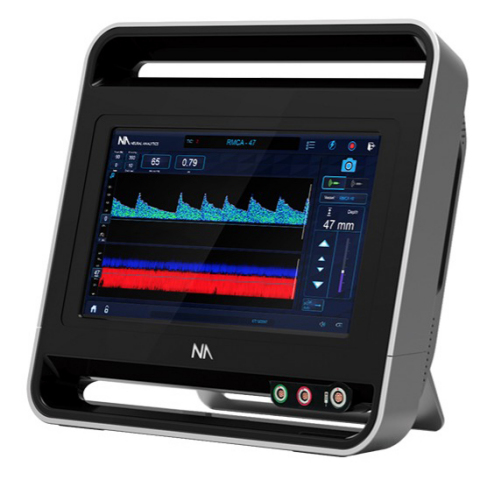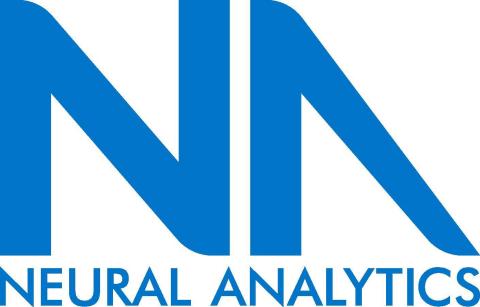LOS ANGELES--(BUSINESS WIRE)--Neural Analytics, Inc., a medical device company developing and commercializing technology to measure, diagnose and track brain health, today announced the results from the first phase of the EXPEDITE (Expedite a NeXt Generation PortablE Diagnostic Platform for Determination and Immediate Triage of Emergency Large Vessel Stroke) program, which (under IRB approved investigation) demonstrates the company’s advanced Transcranial Doppler (TCD) technology platform was accurate with over 94 percent area under the curve (AUC) for early measurement of acute ischemic stroke (AIS) due to large vessel occlusion (LVO). The data was presented at the 10th annual Society of Vascular and Interventional Neurology (SVIN) meeting in Boston, MA.
“The research results of the EXPEDITE program demonstrate that Neural Analytics’ portable diagnostic platform, the Lucid System, has the potential to influence how fast we detect stroke, triage and treat patients,” said Thomas Devlin, M.D., medical director of Erlanger’s Southeast Regional Stroke Center, 2017 SVIN Stroke Workshop chair and principal investigator of the study. “We are honored to be the first site in the world to evaluate this technology with the goal of improving our stroke patient outcomes.”
Dr. Devlin, Ph.D., presented the data demonstrating that Neural Analytics’ Lucid System is capable of measuring and displaying LVO with 91 percent sensitivity and 85 percent specificity as compared to the current standard of care imaging in persons suspected of having a stroke.
The first phase of the EXPEDITE program enrolled patients at Erlanger Southeast Regional Stroke Center in Chattanooga, Tenn., and Baptist Stroke & Cerebrovascular Center in Jacksonville, Fla., to examine the feasibility of Neural Analytics’ Lucid TCD Ultrasound System in the measurement of cerebral blood flow in patients with LVO.
“With the Lucid System, we can look inside the brain at blood flow patterns in real time and identify physiological changes associated with brain disorders including stroke,” said Robert Hamilton, Ph.D., co-founder and chief scientific officer of Neural Analytics. “This technology has the potential to dramatically influence how we measure and track patients with serious brain injuries all across the world.”
The Lucid System studied in the EXPEDITE program is comprised of two key components: an FDA cleared transcranial ultrasound system, and an IRB-approved investigational automation technology designed to simplify data collection for healthcare practitioners. Advanced technologies like the Lucid System can dramatically improve healthcare management for patients who suffer from stroke each year by providing a device to help physicians triage these patients quickly and accurately.
The Lucid System uses TCD ultrasound to assess the brain’s blood vessels from outside the body. This analysis is non-invasive, can be performed in the physician’s office, and helps the physician diagnose brain disorders, potentially without the need for additional, more invasive tests. Many significant brain disorders, such as LVO, cause dangerous blood flow disruptions. The Lucid System is a battery-operated, medical-grade tablet device designed to be transported easily throughout a medical facility and in a range of settings that require the rapid assessment of blood flow in the brain to expedite treatment.
The research study evaluated 107 subjects either experiencing computed tomography angiography (CTA)-confirmed AIS due to LVO of the internal carotid artery (ICA) or middle cerebral artery (MCA) or healthy controls. TCD scans in LVO patients were recorded in 30 second intervals across multiple depths for each brain hemisphere while patients were treated with a drug or awaited endovascular or surgical treatment.
Globally, and each year, strokes affect about 16 million people and kill an estimated 5.7 million people with an annual U.S. healthcare cost of $104 billion.1-4 Stroke is a time sensitive disease and requires intervention as soon as possible. Without appropriate diagnosis and treatment of stroke, a majority of patients may suffer permanent disability or death. Despite recent advances in life saving surgical treatments, less than 10 percent of eligible stroke patients are treated surgically due to the lack of a portable diagnostic device for early detection.2-4
Neural Analytics’ Lucid M1 System is FDA cleared and CE marked for the monitoring of blood flow velocities in the cerebral vasculature.
About SVIN Annual Meeting
The SVIN annual meeting is hosted by the Society of Vascular and Interventional Neurology and includes scientific presentations covering the full spectrum of cerebrovascular diseases and stroke. This academic meeting is intended to bring together hospital administrators, EMS providers, physicians, nurses, coordinators, technologists, and other stroke champions from primary and comprehensive stroke centers. Participants have the opportunity to discuss embolectomy, aneurysms and AVMs, subarachnoid and intracranial hemorrhage, endovascular saves and innovative approaches, new device reviews, international perspectives, and other-related topics.
About Neural Analytics, Inc.
Neural Analytics was founded in 2013 to create products and services to measure, diagnose and track brain health. The company’s current focus is on acute ischemic stroke, traumatic brain injury and dementia. They combine leading data science with cutting edge hardware to allow first responders and clinicians to accurately assess and monitor brain health issues. Their devices are designed to be portable, autonomous, reliable and produce precise and objective physiological measurements for medical responder monitoring of neural disorders.
About Erlanger Health System
The Erlanger Health System is an academic medical center affiliated with the University of Tennessee College of Medicine and is a Level-One Trauma Center for adults and through Children’s Hospital at Erlanger, the region’s only pediatric hospital. The health system consists of five hospitals and six emergency centers, and has a fleet of five air ambulances, based in Tennessee and Georgia. Erlanger is the seventh largest public healthcare system in the United States and has half a million patient visits a year.
About Baptist Health
Baptist Health is a faith-based, mission-driven system in Northeast Florida comprised of Baptist Medical Center Jacksonville; Baptist Medical Center Beaches; Baptist Medical Center Nassau; Baptist Medical Center South; Baptist Clay Medical Campus and Wolfson Children’s Hospital – the region’s only children’s hospital. All Baptist Health hospitals, along with Baptist Home Health Care, have achieved Magnet™ status for excellence in patient care. Baptist Health is part of Coastal Community Health, a regional affiliation between Baptist Health, Flagler Hospital and Southeast Georgia Health System forming a highly integrated hospital network focused on significant initiatives designed to enhance the quality and value of care provided to our contiguous communities. Baptist Health has the area’s only dedicated heart hospital; orthopedic institute; women’s services; neurological institute, including comprehensive neurosurgical services, a comprehensive stroke center and three primary stroke centers; a Bariatric Center of Excellence; a full range of psychology and psychiatry services; urgent care services; and primary and specialty care physicians’ offices throughout Northeast Florida. The Baptist MD Anderson Cancer Center is a regional destination for multidisciplinary cancer care which is clinically integrated with the MD Anderson Cancer Center, the internationally renowned cancer treatment and research institution in Houston. For more details, visit baptistjax.com.
More information is available at http://www.neuralanalytics.com.
Sources:
1. Ganesalingam, J. Cost Utility Analysis of Mechanical Thrombectomy Using Stent Retrievers in Acute Ischemic Stroke. Stroke. 2015 Sep;46(9):2591-8. doi: 10.1161/STROKEAHA.115.009396. Epub 2015 Aug 6.
2. Saver, J. et. Al. Stent Retriever Thrombectomy after Intraveneous t-PA vs. t_PA alone in stroke. N Engl J Med 2015; 372:2285-2295
3. Ovbiagele, B. et. Al Forecasting the Future of Stroke in the United States. Stroke. 2013. http://stroke.ahajournals.org/content/44/8/2361.abstract
4. Age Ageing (2009) 38 (1): 4-5.doi: 10.1093/ageing/afn282




